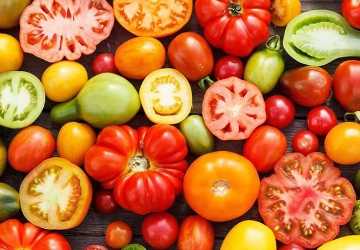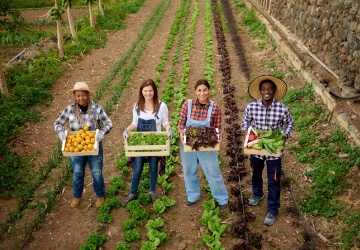Why Heirloom Vegetables Are Making a Return in Kitchens Around the World
Once a staple of outdated gardening practices, heirloom vegetables are experiencing a renaissance in modern cuisine. More and more people are choosing to grow and prepare these ancient varieties, recognizing their countless advantages over modern produce. This article explores the underlying reasons for the popularity of heirloom vegetables and explains their unique characteristics, cultural relevance, and culinary benefits.
Once a staple of outdated gardening practices, heirloom vegetables are experiencing a renaissance in modern cuisine. More and more people are choosing to grow and prepare these ancient varieties, recognizing their countless advantages over modern produce. This article explores the underlying reasons for the popularity of heirloom vegetables and explains their unique characteristics, cultural relevance, and culinary benefits.
The Unique Appeal of Heirloom Vegetables
What Are Heirloom Vegetables?
Heirloom vegetables are plant varieties that have been carefully preserved and propagated over generations (usually at least half a century). They are open-pollinated and rely on natural pollination mechanisms such as wind, insects, or birds. Unlike hybrid or genetically modified vegetables, heirloom vegetables retain their genetic heterogeneity, which contributes to their unique flavor, color diversity, and morphological characteristics.
The Culinary Benefits of Heirloom Vegetables
One of the main reasons for the growing popularity of heirloom vegetables is their unparalleled flavor. Many foodies and home cooks enjoy the rich, complex flavors inherent in heirloom vegetables. Cooking with heirloom vegetables can result in a more diverse and delicious culinary experience. Key culinary advantages include:
- Flavor Advantage: Heirloom vegetable recipes often have stronger and more diverse flavor profiles than hybrid varieties.
- Uniqueness of Texture: These vegetables can have a variety of textures, from the crunch of heirloom carrots to the creamy consistency of heirloom tomatoes.
- Aesthetic Appeal: Heirloom vegetables come in a range of shades and shapes, enhancing the visual appeal of culinary creations.

Nutritional Value
Heirloom vegetables are increasingly popular due to their high nutritional value. They often contain higher concentrations of vitamins, minerals, and antioxidants than their commercial counterparts. This makes cooking with heirloom vegetables a healthy choice for those who want to enrich their diet with nutrient-dense foods.
Cultural and Historical Significance
Preserving Genetic Diversity
The popularity of heirloom vegetables also stems from a desire to preserve genetic diversity in our food supply. Modern agricultural practices have led to a decrease in crop diversity, with many heirloom varieties at risk of extinction. By growing and preparing heirloom vegetables, gardeners and agronomists help protect the gene pool and ensure these plants are preserved for future generations.
Connection to the Past
Heirloom vegetables have a tangible connection to our agricultural heritage. Each variety has its own historical record, often intertwined with a specific region, family lineage, or cultural traditions. Cooking with ancient vegetables allows us to honor these stories and stay connected to our ancestors.
Growing Heirloom Vegetables
Benefits of Home Gardening
Growing heirloom vegetables in your garden can be a very rewarding endeavor. Here are some of the benefits:
- Improved taste: Homegrown heirloom vegetables often taste better than store-bought produce.
- Economical: Growing your own vegetables can save you a lot of money over time.
- Sustainability: Home gardening reduces the carbon footprint associated with shipping produce.
Tips for Success
To effectively grow heirloom vegetables, consider the following strategies:
- Choose the right varieties: Choose heirloom vegetables that are suited to your climate and soil conditions.
- Start with quality seeds: Get seeds from reputable suppliers to ensure high germination rates and plant vigor.
- Practice crop rotation: Rotate your plants each season to prevent soil depletion and prevent pest infestations.
- Use organic methods: Avoid synthetic chemicals in favor of organic fertilizers and pest control practices.
Cooking with Heirloom Vegetables
Heirloom Vegetable Recipes
Here are some delicious heirloom vegetable recipes to try:
- Heirloom Tomato Salad: Combine a variety of heirloom tomatoes with fresh basil, mozzarella cheese, and a little olive oil for a simple but delicious salad.
- Roasted Heirloom Carrots: Toss heirloom carrots with olive oil, salt, and pepper, then roast until softened and caramelized.
- Heirloom Squash Soup: Puree roasted heirloom squash with vegetable broth, garlic, and herbs for a comforting and nourishing soup.
Cooking Tips
When preparing heirloom vegetables, consider these techniques for the best heirloom vegetable recipes to highlight their unique properties:
- Roasting: Enhances inherent sweetness and depth of flavor.
- Grilling: Adds smoky notes and a charred texture.
- Freshly cooked: Eat heirloom vegetables raw in salads or as a side dish to enjoy their authentic flavor.
The Future of Heirloom Vegetables
Trends in Sustainable Nutrition
The growing popularity of heirloom vegetables is emblematic of a broader trend toward sustainable and conscious consumption. Consumers are increasingly aware of the impact their eating habits have on the environment and are seeking out alternatives that increase biodiversity and reduce their carbon footprint. Cooking with heirloom vegetables follows these principles, offering a way to enjoy delicious food while promoting sustainability.
Support Local Farmers
Purchasing heirloom vegetables from local farmers markets strengthens small-scale agriculture and preserves traditional farming methods. By choosing heirloom varieties, consumers can promote a more diverse and resilient food system.
Health Benefits of Heirloom Vegetables
Increased Phytochemical Content
Heirloom vegetables are becoming increasingly popular for their increased content of phytochemicals, which are bioactive compounds synthesized by plants as a defense mechanism against environmental stressors. These compounds, including flavonoids and carotenoids, have significant health benefits, such as:
- Antioxidant properties: Phytochemicals neutralize reactive oxygen species, mitigate oxidative stress and reduce the risk of chronic disease.
- Anti-inflammatory effects: Regular consumption of heirloom vegetables can reduce inflammation and may provide relief for conditions such as arthritis and cardiovascular disease.
Increased Fiber Content
- Improves gastrointestinal motility: Fiber promotes efficient movement of food through the digestive tract, preventing constipation and promoting regular bowel movements.
- Blood sugar regulation: Fiber slows the absorption of glucose, helping to maintain stable blood sugar levels and reducing the risk of diabetes.
- Benefits to the cardiovascular system: A diet rich in fiber can reduce serum cholesterol levels, thereby reducing the risk of atherosclerotic cardiovascular disease.
Impact of Growing Traditional Vegetables on the Environment
Promote Biodiversity
- Improves ecosystem resilience: Biodiversity improves the ability of ecosystems to recover from disturbances such as pests and diseases.
- Supports pollinators: A variety of plant species provide important habitats and food resources for pollinators, which are essential for the reproduction of many crops.
- Strengthens soil health: The different root structures and organic debris of various traditional plants improve soil structure and fertility.

Reduces Reliance on Chemicals
- Reduces pesticide exposure: Reduced pesticide use can lead to cleaner aquatic ecosystems and healthier terrestrial biomes.
- Prevents soil degradation: Organic farming methods improve soil vitality and reduce erosion and nutrient deficiencies.
- Promotes beneficial biota: An environment free of synthetic chemicals supports beneficial insects and microorganisms that naturally regulate pest populations.
Conclusion
The resurgence of traditional vegetables in kitchens around the world is a testament to their enduring appeal. From their superior flavor qualities and nutritional value to their cultural significance and role in maintaining genetic diversity, traditional vegetables offer many benefits. By growing, sourcing, and preparing traditional vegetables, we can enjoy richer culinary experiences while supporting sustainable and diverse food systems.





